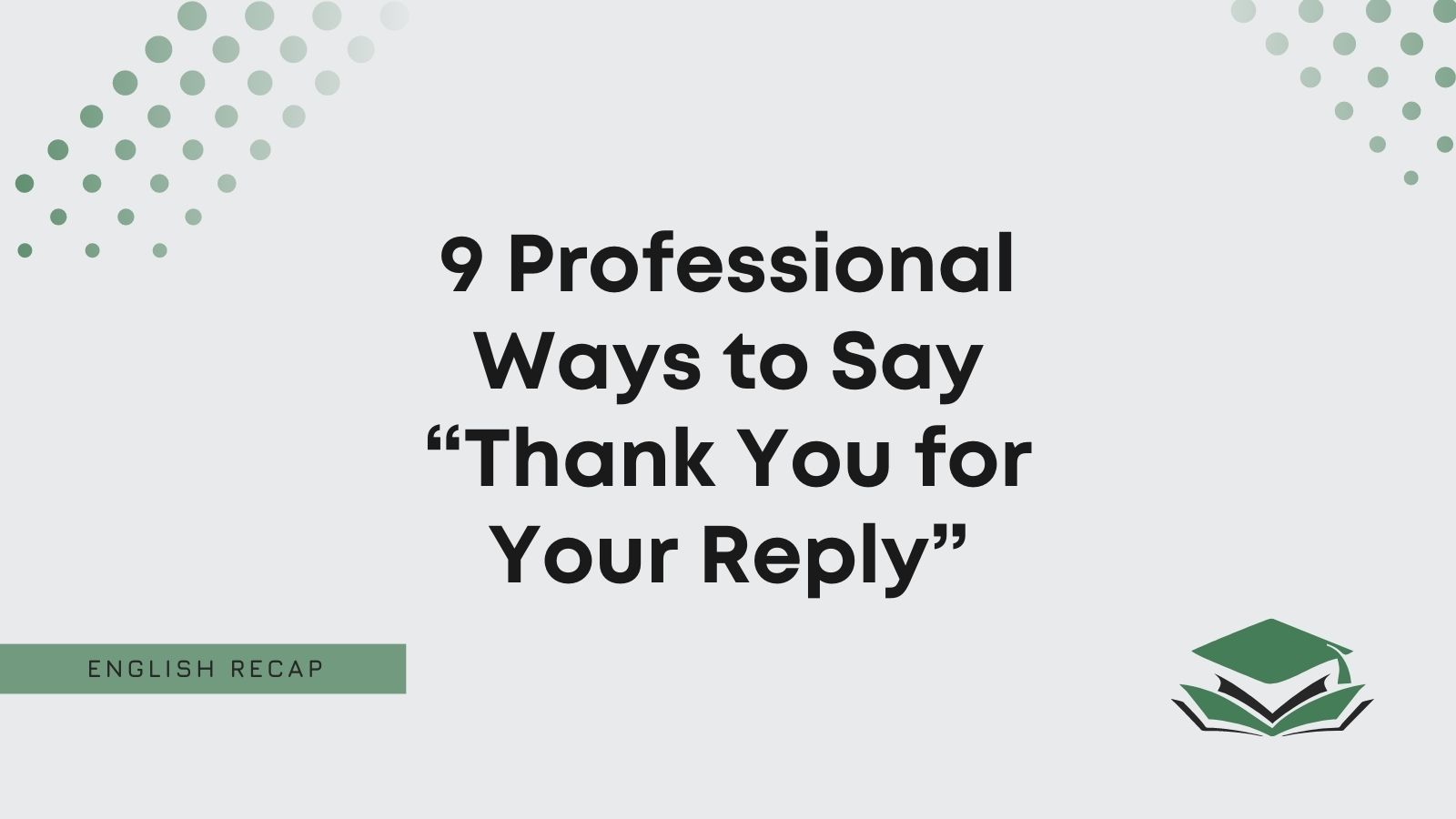Respect and politeness fit into nearly every professional situation. Therefore, it’s wise to thank people when they get back to you, regardless of the email’s context.
Are there more professional alternatives to “thank you for your reply,” though? After all, you don’t want to settle for that phrase if there are more interesting ones available.
This article has gathered some synonyms to show you how to say “thank you for your reply” professionally.
Is It Polite to Say “Thank You for Your Reply”?
It is polite to say “thank you for your reply.” It’s not rude and is highly effective in a formal email.
It’s a professional way to show gratitude after someone gets back to you. It tends to work best when you’re impressed by the speed of the reply.
Check out the following example to see how it works:
Thank you for your reply. You were much quicker than I expected, and I can now move forward with what’s next.
Pros
- It’s a simple yet effective way to say “thank you.”
- It’s very professional.
Cons
- It’s quite impersonal (especially if a lot of thought went into someone’s reply).
- It’s overused.
So, “thank you for your reply” is a great choice for professional writing. However, it’s not the only one. There are always alternatives to help you mix things up.
Keep reading to learn what to say instead of “thank you for your reply.” We also recommend reviewing the examples under each heading.
What to Say Instead of “Thank You for Your Reply”
- Thank you for your email
- Thanks for responding
- Thank you for getting back to me
- I appreciate your reply
- I’m glad you replied
- Thanks for replying
- Your reply is appreciated
- Thanks for emailing
- Thanks for your swift response
1. Thank You for Your Email
Formal emails don’t require overly complicated language and phrases. Sometimes, simple choices like “thank you for your email” work the best.
You do not need to highlight a “reply” or “response” when thanking someone. Instead, you can thank them for sending an email directly.
Generally, this works when thanking customers for checking in. It shows you appreciate them reaching out, even if you have nothing productive to share or “reply” to.
Here’s a helpful example to show you how it works:
Dear Billy,
Thank you for your email. I appreciate that things aren’t easy at the moment. However, I believe we’re making headway.
Yours,
Brian Ratchet
2. Thanks for Responding
If you’ve sent someone an email and they’ve responded, it’s appropriate to say thanks. It’s a good way to build a more friendly and polite relationship with the recipient.
That’s where “thanks for responding” comes in. It shows you’re happy to hear back from a recipient.
For example, you can use it to thank clients for replying. It often works best when they reply much quicker than you expected as well.
We also recommend reviewing the following example:
Dear Tommy,
Thanks for responding so quickly. I’m so happy to hear from you, and I’m keen to find out more about this.
Yours,
Darryl Tayler
3. Thank You for Getting Back to Me
There’s nothing wrong with sounding a bit more friendly in your formal emails. Even if you’re addressing someone you respect, it sometimes helps to sound conversational and happy.
We recommend trying “thank you for getting back to me” as another way to say “thank you for your reply.”
It’s a little more casual and polite. You can use it when addressing your boss. It shows you reached out to them previously and are happy to receive a detailed response from them.
The following example will also help you understand it:
Dear Mr. Smith,
Thank you for getting back to me. I have since discovered new information that might help us complete this project.
All the best,
Charlotte Church
4. I Appreciate Your Reply
Feel free to include “I appreciate your reply” as a more formal way to say “thank you for your reply.” It’s very effective in professional emails after someone gets back to you.
In most cases, “I appreciate” and “thank you” are interchangeable. That’s why they are both effective phrases.
The only major difference is that “I appreciate” comes across as much more formal than “thank you.”
For that reason, try using it when emailing clients. It shows you’re happy to hear from them and glad they could reply to give you more information.
Here’s a great sample email to help you with it:
Dear Ms. Harrington,
I appreciate your reply. Thank you so much for reaching out, and I’ll be certain to get on top of this for you.
Best regards,
Timmy Taylor-Smith
5. I’m Glad You Replied
Conversational writing in emails isn’t always the best choice. There are times when it’s useful, but you need to be friendly with the recipient beforehand.
A conversational phrase like “I’m glad you replied” works well to demonstrate a friendship with the recipient.
You can use it when emailing customers. If you get on well with the customer that responded, this is a great way to start an email to demonstrate how close you might be.
Certain companies like to be more friendly and conversational with their customers. Others don’t. This phrase is for you if you work for a company that values friendliness above all else.
You can also review the following email sample:
Dear Waldo,
I’m glad you replied to my previous email. I have a few things to share with you that I think will be of interest.
All the best,
Dean Adams
6. Thanks for Replying
We’d like to keep things a little simpler for this alternative. You can use “thanks for replying” instead of “thank you for your reply.”
Naturally, not much has changed from the original phrase. In fact, we’ve only switched “thank you” to “thanks” and changed “reply” to the gerund form (replying).
While it’s not a huge difference, this phrase is still polite and respectful.
You should use it when you’re thankful for someone’s quick response. It shows you appreciate them reaching out to provide you with information.
Check out this example if you still need help:
Dear Daniel,
Thanks for replying. I will let you know when I have more information. For the time being, I hope you stay well.
Best,
Paul Blart
7. Your Reply Is Appreciated
“Your reply is appreciated” is a formal way of saying “thank you for your reply.” It works well when you don’t know the recipient well (i.e., if you’re speaking to them for the first time).
So, which situations are most appropriate to use a phrase like this?
You can include “your reply is appreciated” when emailing new clients. It shows you’re keen to work with them and have a more formal yet friendly discussion with them.
Perhaps this email example will also help you with it:
Dear Ms. Rogers,
Your reply is appreciated. Thank you for taking the time to get back to me and let me know how things are going.
Yours,
Jonathan Watmore
8. Thanks for Emailing
There’s not always a need to add “reply” in “thank you for your reply.” Sometimes, simply being grateful for the email is the best way to handle things.
That’s why “thanks for emailing” is a suitable formal synonym.
You can use it after someone replies to your request. It suggests you’re happy to hear from them and glad they took the time to reach out.
Here’s a great sample email to help you:
Dear Madeline,
Thanks for emailing me back. I’ll let you know as soon as I have more information regarding your application.
Kind regards,
Samson Danforth
9. Thanks for Your Swift Response
It’s worth highlighting the speed of the reply in some cases. If someone replies really quickly, feel free to highlight this with your choice of synonym.
For example, you can write “thanks for your swift response.” It’s highly effective when you’re impressed with someone’s reply speed.
We recommend using it when emailing a customer back. It shows you’re happy they answered a question you had, especially if it helps you with their original request.
You can also refer to this email example:
Dear Haley,
Thanks for your swift response to this matter. I’ll let you know when I have a few updates to pass on.
All the best,
Morris Dancer

